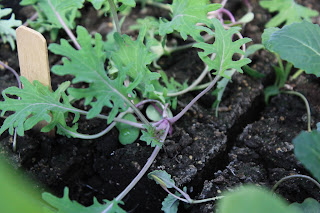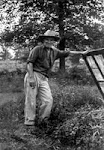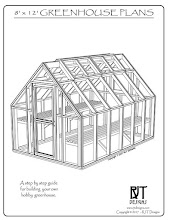A sure sign of spring at our house is when the asparagus first start to appear from their wintery nap. Last week I was a little disappointed when I raked the leaves off the bed and didn't see any spears poking up. Yesterday was blustery and stormy, but today the sun is shinning and it is much warmer. The asparagus spears are just starting to poke up out of the ground!
Last fall I planted carrots to see if I can overwinter them to get an early crop this year. They survived the cold and snowy winter with only the protection of a row cover on hoops. They were buried under a foot or two of snow turning dark purple color. Now that the days are getting warmer and the sun is shining more they are growing like crazy! I dug a couple up, an early treat for my rabbit, they are about 6" long with 6"-8" tops. We should have a nice variety of early carrots late in the spring.
 |
| Scallions overwintered in garden |
The scallions and chives all survived the winter as well and are growing thick and tall. The scallions will need to be thinned and transplanted to another bed soon. They were started from seed last summer. The scallions I transplanted into the cold frames in November are three times as big as these, we have been harvesting them over the past few weeks.
IN THE COLD FRAMES...
The scallions, cabbage, lettuce, garlic, sage, kale and broccoli survived the winter in the mini-greenhouses. Although it grew slowly, we were still able to harvest lettuce and scallions several times throughout the winter. With the warmer days and nights everything is really starting to get big. We have been harvesting scallions the size of our thumbs with tops 12" tall!
 |
| Lettuce in the cold frame planted last fall |
IN THE GREENHOUSE ...
The greenhouse is chock full of seedlings growing rapidly awaiting their transplanting into the garden. I have already started several varieties of lettuce, kale, tomatoes, peppers, eggplant, onions, leeks, beets, spinach, parsley, basil, sage, thyme and cucumbers. We have had a few nights that dipped into the low 30's so I have been moving the trays into the basement on those cold nights. I have many different varieties of heirloom tomatoes which are growing nicely in their 2" soil blocks.
 |
| Tomato plants in greenhouse. |
The heirloom tomatoes are growing nicely in their 2" soil blocks. I have only started organic, non-gmo, non-hybrid, heirloom tomatoes this year with plans on saving the seeds for next year.
 |
| Heirloom tomatoes. |
This is the first year I have had success growing romaine and butter head lettuce. They were started in 3/4" soil blocks and then transplanted into trays. I have been leaving them in the greenhouse overnight on the cold nights and they have been thriving in the cooler temperatures.
 |
| Romain lettuce. |
Last year was the first time we dried our own herbs and really enjoyed the fresh flavor of them during the winter so this year we are planning on expanding our herb garden with lots of basil, parsley, sage, oregano, thyme, rosemary and chives!
 |
| Basil. |

 |
| Red Russian Kale in 2" soil blocks. |
The next big project is to expand the garden and fence it in so I can get the lettuce, kale and other seedling planted. We are planning on tripling the size of the beds and planting bio-intensively in hopes to grow as much of our own food this summer as possible and preserve some for winter use. We are also working on another exciting project this year, creating a school community garden at our Elementary School! You can follow that project on
facebook!



























































